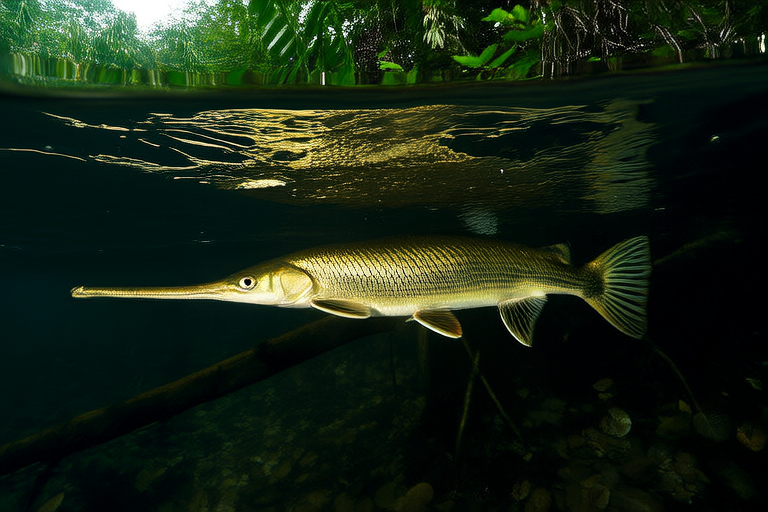From Jungle Streams to Your Aquarium: The Stunning World of Arowanas
Arowanas are among the most majestic and historically significant fish in the world. Their sleek, elongated bodies and powerful jaws make them stand out in any environment. These ancient creatures have been revered for centuries, symbolizing good luck and fortune in many cultures. In this article, we will explore the fascinating world of arowanas, from their natural habitats in Asian jungles to their role in modern aquariums.
The Majestic Appearance and Historical Significance
Arowanas are known for their striking appearance, with shimmering scales that reflect light beautifully. They possess long, streamlined bodies that allow them to swim gracefully through water. Their large, upward-facing mouths are equipped with sharp teeth, making them formidable predators. Historically, arowanas have held great significance in various cultures. In Chinese tradition, they are believed to bring wealth and prosperity, often referred to as ‘dragonfish’ due to their resemblance to mythical dragons. This association has made them highly sought after as ornamental fish.
Natural Habitat and Key Species
Native to the tropical regions of Asia, arowanas thrive in the warm, oxygen-rich waters of jungle streams and rivers. They are found in countries such as Indonesia, Malaysia, Thailand, and Vietnam. Among the most popular species are the Asian arowana (Scleropages formosus) and the silver arowana (Osteoglossum bicirrhosum). The Asian arowana, also known as the dragonfish, comes in various colors, including red, green, and albino. The silver arowana, on the other hand, is known for its silvery scales and distinctive long pectoral fins.
Physical Adaptations for Survival
Arowanas have evolved several unique physical adaptations that enable them to survive in their challenging natural habitats. Their sleek bodies reduce drag, allowing them to move swiftly through the water. Additionally, their powerful jaws and sharp teeth are perfect for catching prey, which can range from insects to small fish. Another notable adaptation is their ability to breathe air. Arowanas possess a labyrinth organ, which allows them to extract oxygen from the air when water quality is poor or oxygen levels are low. This feature is particularly useful during dry seasons when water levels drop.
Challenges and Considerations for Aquarium Owners
For those interested in keeping arowanas in their home aquariums, there are several important factors to consider. First and foremost, arowanas require a spacious tank to accommodate their size and swimming habits. A minimum tank size of 300 gallons is recommended for adult specimens. The tank should be equipped with robust filtration systems and efficient heaters to maintain optimal water conditions. Water temperature should be kept between 78°F and 84°F, while pH levels should be slightly acidic, around 6.5 to 7.0.
Proper tank setup is crucial for the health and well-being of arowanas. A sandy substrate is ideal, as it mimics their natural riverbed environment. Decorations such as driftwood and rocks can be added to provide hiding spots and create a more natural setting. It’s important to note that arowanas are territorial and can become aggressive towards other fish, especially those of similar size. Therefore, careful consideration should be given to tank mates to avoid conflicts.
Diet is another critical aspect of arowana care. In the wild, they are carnivorous, feeding on insects, small fish, and crustaceans. In captivity, a varied diet of high-quality pellets, frozen foods, and live feeders such as feeder fish and shrimp is recommended. Regular feeding schedules and proper portion control are essential to prevent overfeeding and maintain water quality.
Cultural Importance and Conservation Status
Arowanas hold significant cultural importance in many parts of Asia. In addition to their symbolic value, they are also highly prized for their beauty and rarity. However, their popularity has led to overharvesting and habitat destruction, resulting in declining populations in the wild. Several species of arowanas are now listed as endangered or vulnerable under the Convention on International Trade in Endangered Species of Wild Fauna and Flora (CITES).
To ensure the survival of these magnificent creatures, responsible ownership practices are essential. This includes purchasing only captive-bred specimens and supporting conservation efforts. Many organizations are working to protect arowana habitats and promote sustainable breeding programs. By choosing to keep arowanas responsibly, aquarium enthusiasts can contribute to the preservation of these remarkable fish for future generations.
In conclusion, arowanas are truly remarkable fish with a rich history and unique characteristics. Their stunning appearance, combined with their cultural significance, makes them a captivating subject for both aquarists and general readers interested in aquatic life. By understanding their needs and taking steps to ensure their well-being, we can enjoy these beautiful creatures while contributing to their conservation.
